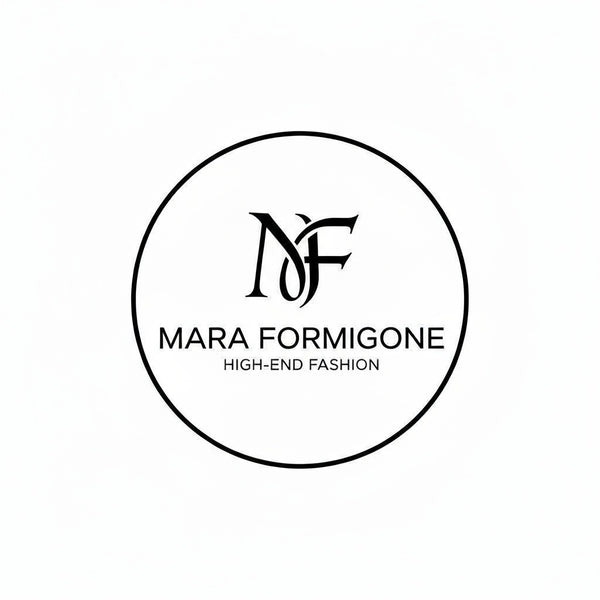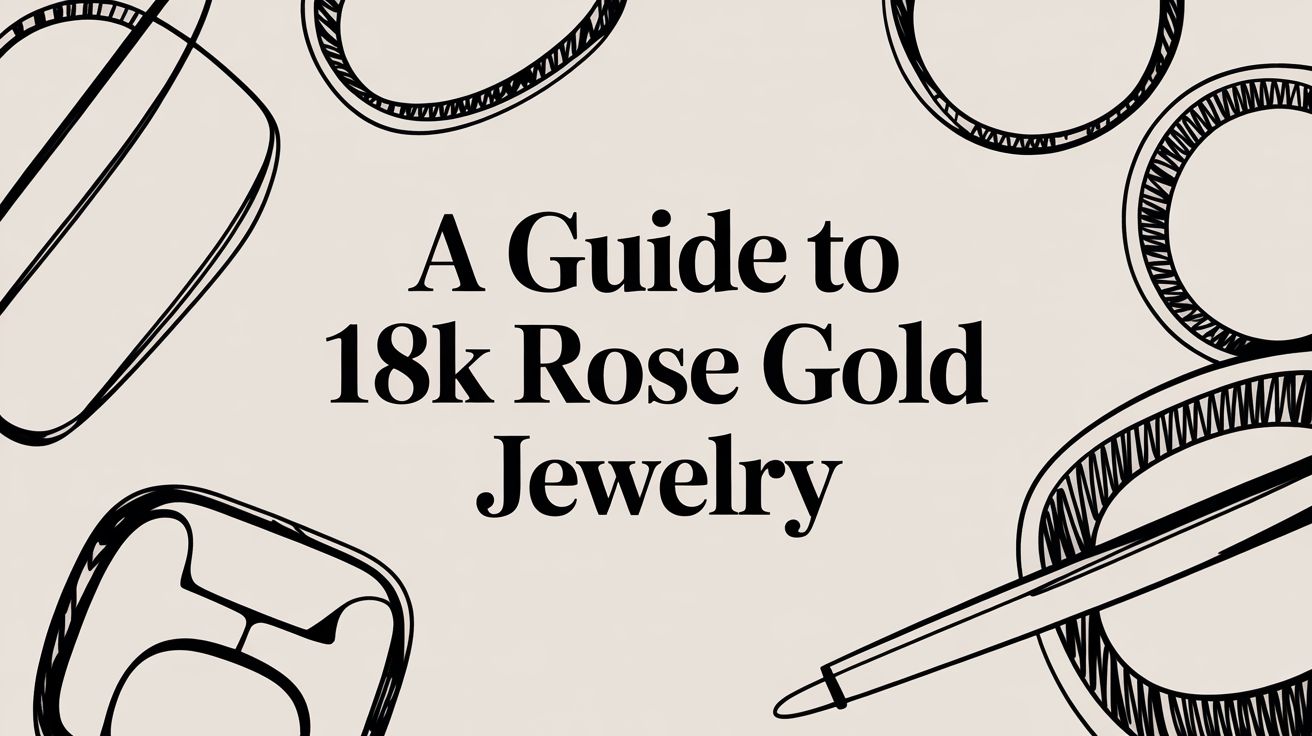With its warm, pinkish hue and luxurious feel, 18k rose gold has become a go-to choice for those seeking something special. It’s an alloy made from 75% pure gold mixed with copper and a touch of silver, a combination that strikes the perfect balance between the opulence of gold and everyday durability. This specific blend is what gives the metal its signature romantic color, setting it apart from classic yellow and white gold.
What Makes 18k Rose Gold Special
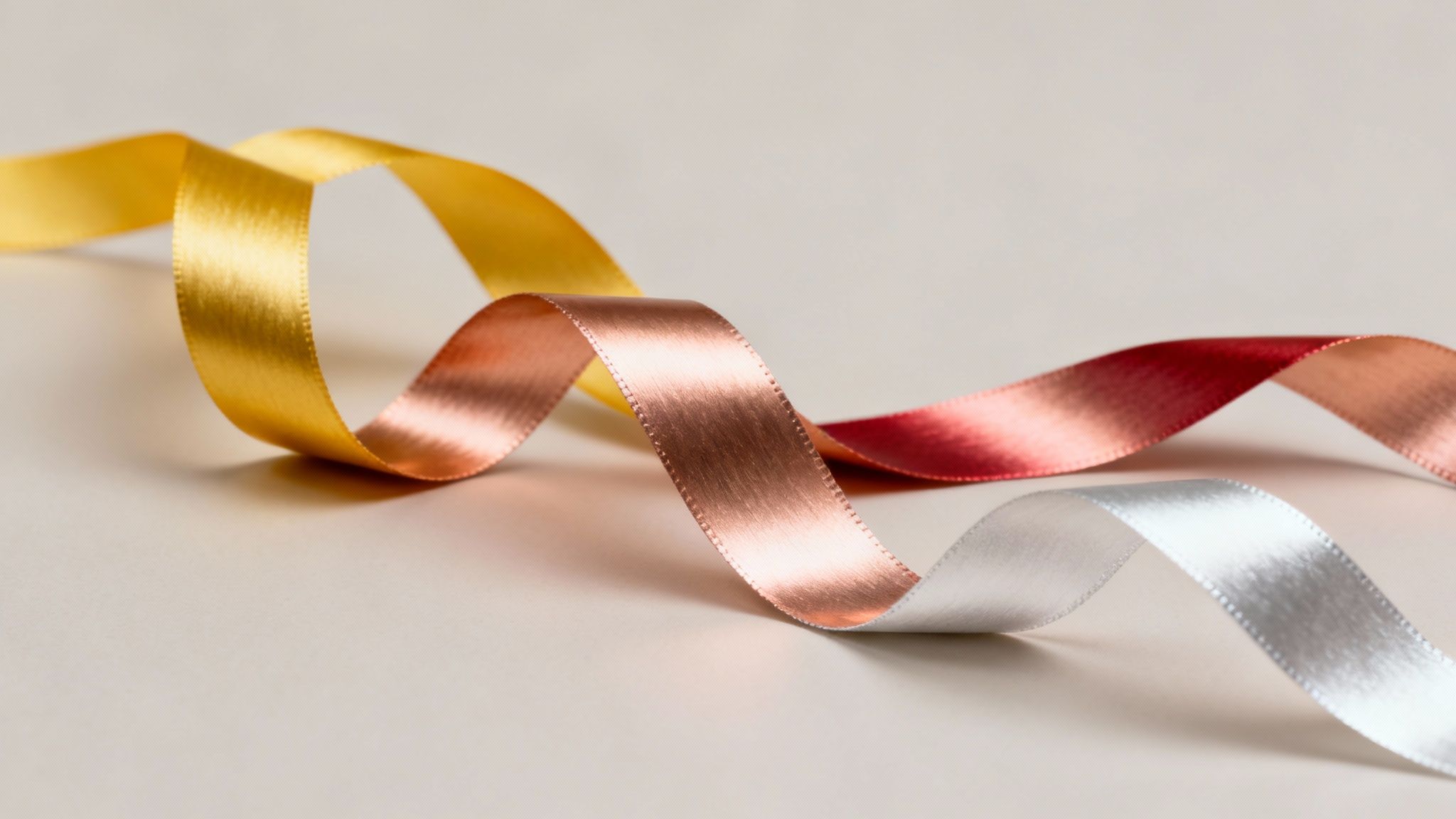
The unique appeal of 18k rose gold goes far beyond its beautiful color; it’s really a story of masterful metallurgy. Instead of thinking of it as a simple coating, imagine it as a chef's secret recipe. Pure gold on its own is quite soft, but this precise mixture transforms it into something new and much more resilient.
The magic ingredient behind that iconic blush tone is copper. By introducing copper into the mix, jewelers create an alloy that’s not just visually stunning but also significantly stronger than pure gold. A small amount of silver is often added as well, helping to soften the red tones from the copper and land on that perfect, warm glow.
The Perfect Blend of Metals
The very character of 18k rose gold is defined by its composition. The "18k" simply means that out of 24 parts, 18 are pure gold. This high percentage ensures the metal feels substantial and retains the inherent value of gold, while the other metals in the alloy give it strength and that distinctive color.
This specific formula offers a fantastic compromise for fine jewelry:
- High Gold Content: At 75% pure gold, it carries significant precious metal value and has a luxurious weight.
- Enhanced Durability: The copper strengthens the alloy, making it more resistant to scratches and dings from daily wear compared to purer forms of gold.
- Unique Aesthetic: That warm, romantic hue from the copper is incredibly versatile and complements a wide range of skin tones beautifully.
The real beauty of 18k rose gold lies in its perfect harmony. It marries the timeless prestige of high-karat gold with the practical strength and unique color of its copper alloy, creating a metal that is both luxurious and wearable.
A Journey Through History
While it feels incredibly current, rose gold actually has a rich history that adds to its charm. The alloy first gained widespread popularity in 19th-century Russia, where the famed jeweler Carl Fabergé made it a sensation. This legacy gives 18k rose gold an air of vintage elegance and imperial grandeur. You can dive deeper into the history of gold alloys and their market trends on platforms like Barchart.com.
Fast forward to today, and you’ll see it embraced by designers and jewelry lovers all over the world as a symbol of romance and individuality. Its unique color makes it a standout choice for everything from delicate necklaces to bold engagement rings. This combination of historical depth and modern versatility is what makes 18k rose gold so much more than just a passing trend.
So, you know the recipe for 18k rose gold, but what’s it really like to own a piece? Its unique blend of gold and copper isn’t just for looks—it creates a metal with some seriously practical advantages that make it a favorite for everything from engagement rings to those everyday bracelets you never take off.
The secret to its strength lies in that specific mix: 75% pure gold and 25% copper. Think of pure gold—it's incredibly soft and you can easily bend it. Now, imagine mixing in copper, a much tougher metal. The copper acts like a reinforcing skeleton, making the whole alloy surprisingly resilient.
This means your 18k rose gold jewelry is much better at shrugging off the little bumps and scrapes of daily life. It holds its shape beautifully, which is a huge deal for delicate ring settings or any piece you wear constantly.
Surprisingly Tough for Everyday Life
Let's be clear: no precious metal is invincible. But 18k rose gold holds its own remarkably well, especially when you compare it to its siblings. The high copper content makes it noticeably harder than 18k yellow gold, which is typically mixed with softer metals like silver.
This makes it a fantastic, practical choice for pieces that see a lot of action:
- Engagement Rings & Wedding Bands: These rings live on your hand, so that extra resilience is a godsend.
- Bracelets & Bangles: Wrists are high-impact zones! The toughness of 18k rose gold helps prevent dents and dings.
- Everyday Necklaces: You can wear your favorite pendant with confidence, knowing it can handle the day-to-day.
Ultimately, this built-in sturdiness means your jewelry isn't just stunning on day one—it's built to be worn and loved for years to come.
It’s a common myth that more gold always means a weaker piece of jewelry. 18k rose gold is the perfect counterexample. You get that luxurious, high-gold content, but the specific strength of the copper alloy gives it a toughness you might not expect.
A Warm Glow That Flatters Everyone
One of the things people absolutely adore about 18k rose gold is how it looks good on everyone. Seriously. Its soft, warm blush has a unique quality that you don't get from the crispness of white metals or the bold statement of classic yellow gold.
Why is it so universally flattering? It all comes down to that balanced, pinkish hue. It brings a lovely warmth to cooler complexions and perfectly complements the natural undertones in warmer skin. No matter if your skin is fair, olive, or deep, 18k rose gold just seems to cast this beautiful, romantic glow.
Let's Talk Allergies: Is It Hypoallergenic?
If you have sensitive skin, you know how important it is to know what's in your jewelry. The good news is that with 75% pure gold, 18k rose gold is a very safe bet for most people. Gold itself is famously inert, meaning it almost never causes a skin reaction.
But we have to be honest about the other 25%. The main metal mixed in is copper. While a true copper allergy is pretty uncommon, it's not impossible. If you have extremely sensitive skin or a known reaction to copper, it's something to keep in mind.
For the vast majority of us, though, 18k rose gold is a fantastic, mostly hypoallergenic choice. It has far fewer potential irritants than lower-karat golds or white gold alloys that sometimes contain nickel. It’s the perfect blend of high-purity gold and lasting beauty, without the worry.
How 18k Rose Gold Compares to Other Karats
When you're choosing a piece of gold jewelry that you’ll love for years to come, you'll hear the word "karat" thrown around a lot. But what does it actually mean for the look, feel, and durability of your ring or necklace? Getting a handle on the karat system is the key to picking the right metal for you.
Think of "karat" as a simple recipe measuring gold purity, with the total scale adding up to 24 parts. Pure, unadulterated gold is called 24k gold—it's 24 out of 24 parts gold. It's beautiful, but it's also incredibly soft, which is why it's not practical for most jewelry. To make it stronger, jewelers mix it with other metals (alloys), and the karat number tells you exactly how much pure gold is left in that blend.
This is what really sets different types of rose gold apart. The karat you choose impacts everything from how well your jewelry holds up to daily life to its exact shade of pink and, of course, its price.
Durability and Hardness
Here’s something that might surprise you: when it comes to gold, a lower karat number often means a tougher piece of jewelry. It seems backward, but it all comes down to the alloy mix.
- 10k Rose Gold: This is the workhorse of rose gold. It contains 41.7% pure gold, with the rest being strong alloy metals like copper. This makes it incredibly resistant to scratches and dings, perfect for someone who's rough on their jewelry.
- 14k Rose Gold: Sitting right in the middle, 14k contains 58.3% pure gold. It's the sweet spot for many, offering a great balance of durability and gold purity. It's tougher than 18k but has a richer feel than 10k.
- 18k Rose Gold: As the most luxurious option, 18k rose gold is 75% pure gold. While it's certainly strong enough for engagement rings and other daily-wear pieces, its higher gold content makes it a bit softer. You just have to be a little more mindful with it.
If you're an active person or work with your hands, 14k rose gold is a fantastic choice that blends beauty with resilience. But if you truly love the deep, warm glow of high-purity gold and are careful with your pieces, 18k rose gold is an absolutely stunning option.
This infographic gives a great visual breakdown of what makes 18k rose gold so special.
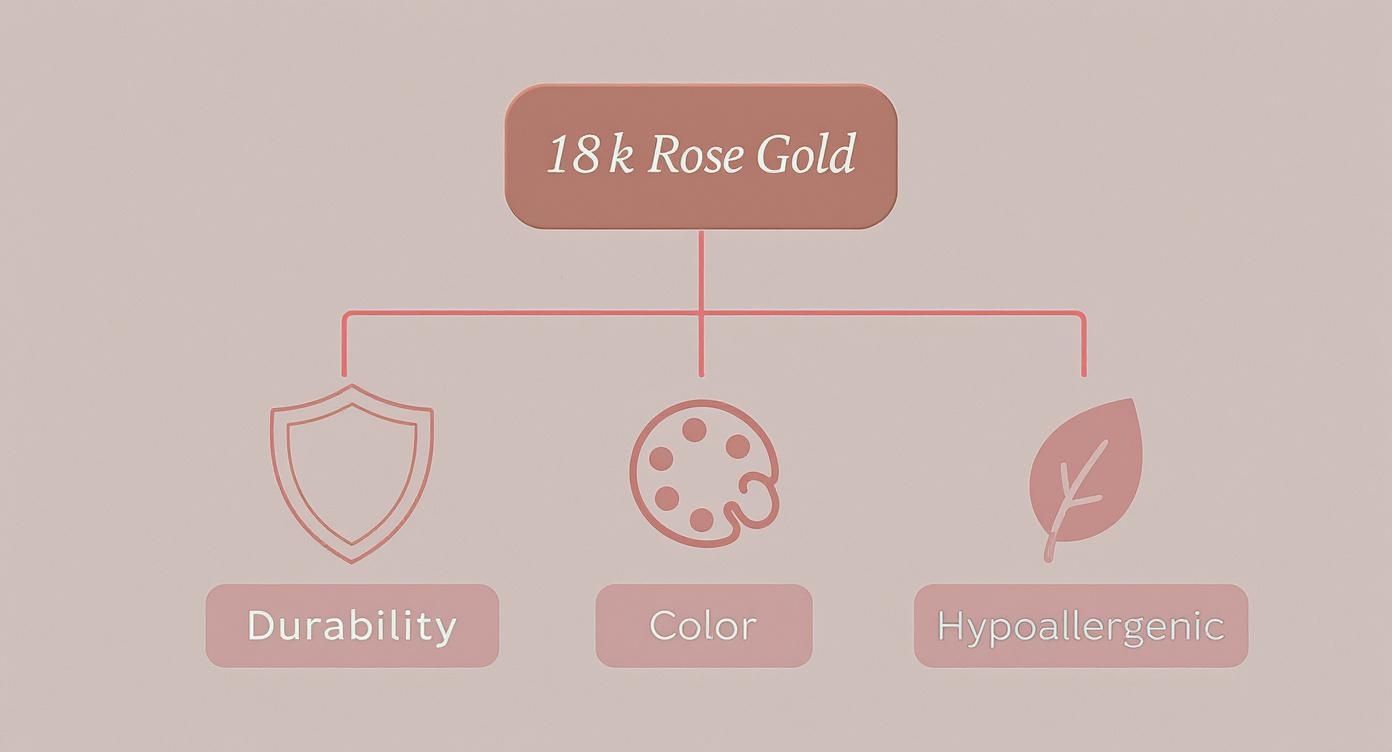
It really shows how 18k rose gold hits that perfect balance between luxury, color, and practicality.
To help you see the differences at a glance, here’s a quick comparison of the three most common rose gold alloys.
Rose Gold Karat Comparison Guide
| Feature | 10k Rose Gold | 14k Rose Gold | 18k Rose Gold |
|---|---|---|---|
| Pure Gold Content | 41.7% | 58.3% | 75% |
| Durability | Highest | High | Good |
| Color Vibrancy | Deep, rosy pink | Warm, classic rose | Soft, champagne-pink |
| Price Point | Most affordable | Mid-range | Premium |
This table makes it easy to weigh what matters most to you—whether it's the toughest metal for everyday wear or the most luxurious, gold-rich alloy.
Color Vibrancy and Purity
The alloy recipe doesn't just determine strength; it also fine-tunes the metal's final color. The more copper in the mix, the more intense and reddish the rose gold will appear.
While the differences can be subtle, you can definitely see them when the metals are side-by-side. 10k rose gold tends to have the deepest, most pronounced pink hue because of its higher copper percentage. On the other end, 18k rose gold offers a much softer, more delicate blush. Its higher gold content gives it a warm, peachy undertone that many people adore. 14k, as usual, lands right in between with a beautiful, rich rosy color that has become a modern classic.
The color of 18k rose gold is often described as a warm, peachy-pink or a "champagne" rose. Its higher gold content gives it a luxurious glow that is less intensely pink than lower karats, appealing to those who love a refined and subtle look.
Price and Overall Value
No surprise here: the karat number is directly tied to the price. Since the cost is driven by the amount of pure gold, the math is simple. The higher the karat, the higher the price tag. An 18k rose gold piece will always cost more than the exact same design made in 14k or 10k.
But the "value" is about more than just the initial cost. For 18k rose gold jewelry, whose value is 75% of the gold price plus brand and manufacturing premiums, this meant significant increases in retail prices across major markets. In North America, gold-backed ETF inflows reached $21 billion in the first half of 2025, reflecting heightened investor interest in gold as a hedge against inflation and market uncertainty—a trend that also supports the precious metal’s value in jewelry. To explore this topic further, you can read the full research on mid-year gold outlooks for 2025.
Choosing a piece like this gorgeous 18k gold plated ring means you're investing in a metal with real, lasting worth. For many, 18k rose gold truly is the perfect choice, delivering an unmatched blend of high gold content, a beautiful, subtle color, and the durability needed for jewelry you'll treasure forever.
Styling 18k Rose Gold Jewelry
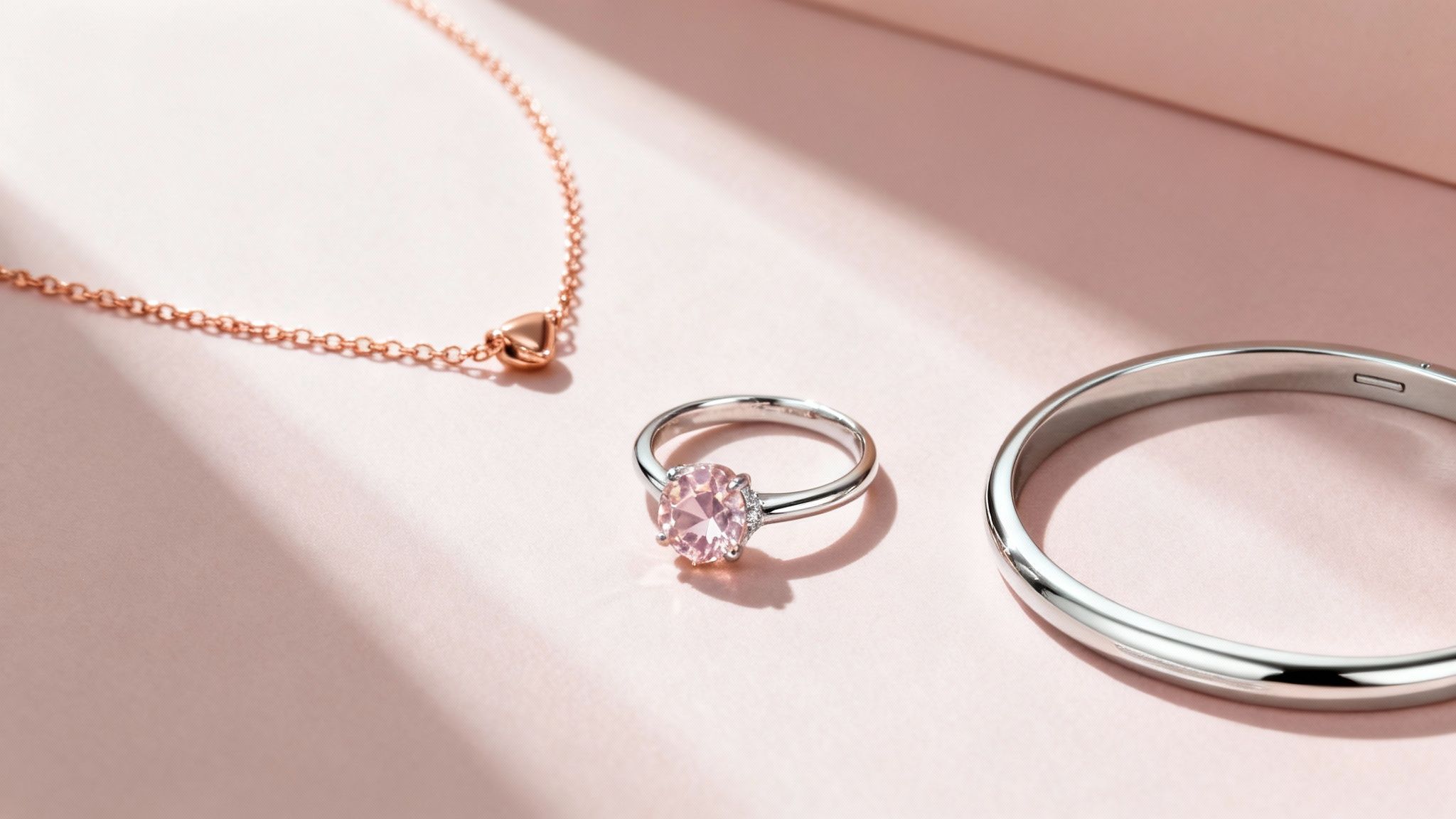
What I love most about 18k rose gold isn't just its composition—it's how incredibly versatile it is. Beyond the numbers and alloys, its warm, subtle hue is the perfect canvas for your personal style. It has a unique ability to elevate any look, from your favorite jeans to a formal gown.
Styling this metal isn't about rigid rules. It's more about feeling how its unique, champagne-pink color plays with other textures, colors, and metals. Think of it as a romantic, soft backdrop that you can dial up or down depending on where you're headed.
Mastering the Art of Mixing Metals
Forget what you've heard about never mixing metals—that rule is long gone. Today, a mixed-metal look is a sign of confident, modern style, and 18k rose gold is the ideal piece to build your collection around.
Its warm undertones create a stunning contrast when you pair it with cooler, silvery metals. Try stacking a delicate 18k rose gold bracelet right next to a classic sterling silver watch or your platinum wedding band. The combination feels intentional, modern, and adds real visual depth. The trick is to make it look cohesive by repeating the theme, maybe with a few layered necklaces or a stack of rings.
Don't be afraid to mix and match. Pairing the warmth of 18k rose gold with the cool brightness of platinum or white gold creates a sophisticated, dynamic look that feels curated and personal.
This approach works wonders for special events. If you're trying to figure out your accessories for a big day, our guide on what to wear to a wedding has some great tips for pulling together a polished look. Sometimes, the soft glow of rose gold is just the thing to tie it all together.
Perfect Gemstone Pairings
The warm blush of 18k rose gold has a special talent for bringing out the best in certain gemstones. It creates a stunning harmony that makes colors pop in a way that traditional yellow or white gold just can't match.
Some of the most breathtaking combinations are:
- Morganite: This is the quintessential pairing. The peachy-pink hues of morganite seem to melt right into a rose gold setting, creating an incredibly romantic, seamless look.
- Moonstone: The ethereal, milky glow of a moonstone against the warmth of rose gold is just magical. It makes the stone’s signature blue flash (adularescence) even more captivating.
- Diamonds: A classic choice, for sure, but diamonds seem to come alive in 18k rose gold. The metal's warmth provides a contrast that makes colorless diamonds look even brighter and whiter.
- Pearls: The delicate luster of pearls, especially ones with creamy or rosy overtones, looks timeless and beautifully feminine when set in rose gold.
From Everyday Elegance to Statement Pieces
One of the best things about 18k rose gold is how it fits into every part of your life. For daily wear, a simple pendant necklace or a pair of small hoops are perfect. Their subtle glow adds a touch of polish to a casual outfit without ever feeling over the top.
When you're dressing up for a bigger event, an 18k rose gold statement piece—like a bold cocktail ring—can be a total showstopper. Because the color itself is so unique, it’s a natural conversation starter while still feeling classic and refined. At the end of the day, this beautiful metal lets you express your own style, whether that's understated and graceful or bold and glamorous.
Caring for Your 18k Rose Gold Pieces
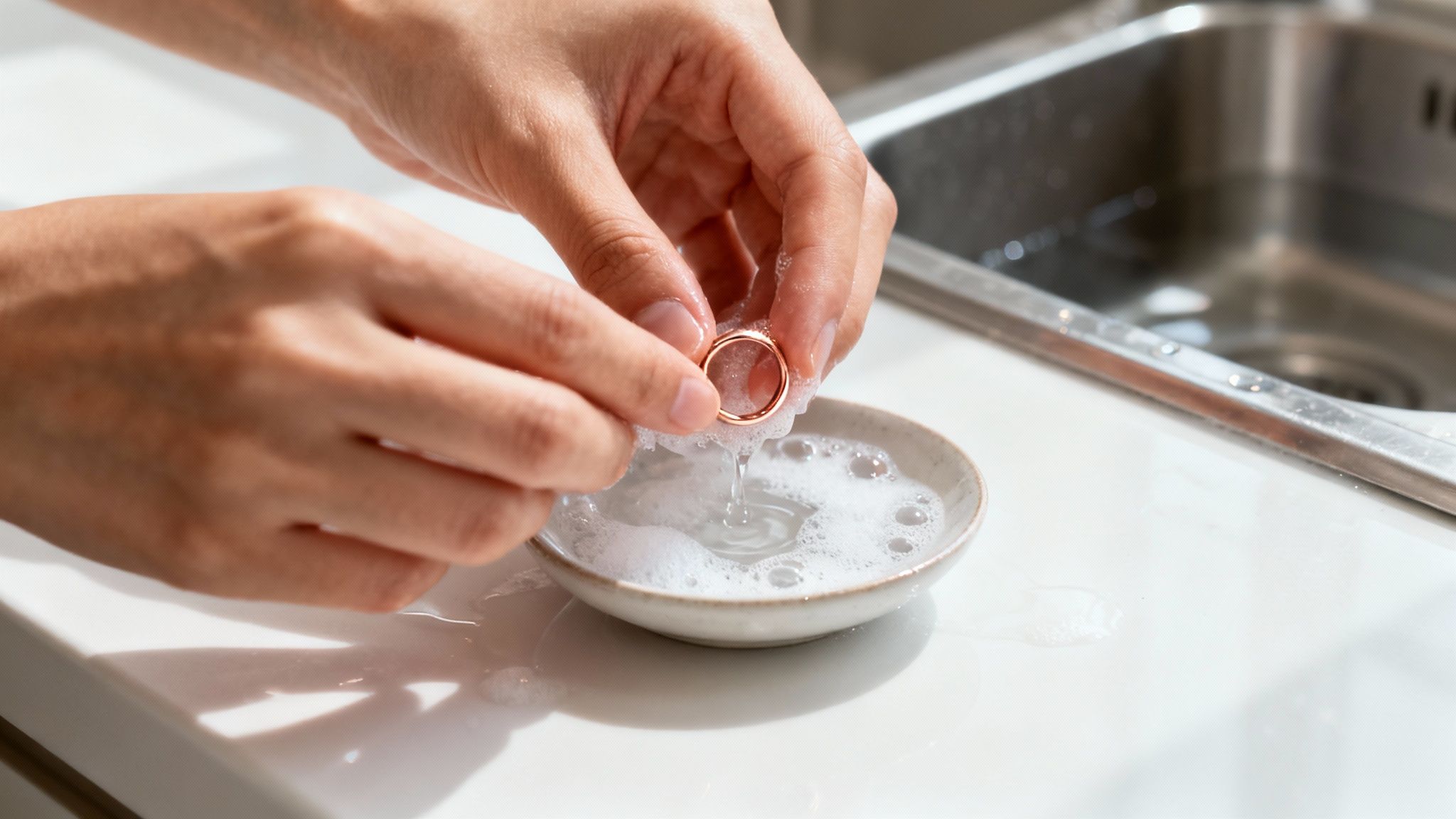
Your 18k rose gold jewelry is a beautiful investment, and the best part is that keeping it that way is surprisingly simple. You don't need any complicated routines or harsh chemicals. With just a little bit of mindful care, you can ensure your pieces maintain their stunning, warm glow for years to come.
The secret is a gentle touch. For routine cleaning, a bowl of warm water mixed with a few drops of mild, phosphate-free dish soap is all you need. This quick and easy solution is perfect for cutting through the everyday grime from lotions, skin oils, and dust that can temporarily dull your jewelry's shine.
Your Simple Cleaning Routine
Try to give your jewelry a quick bath every few weeks or whenever it starts looking a little less brilliant. This process is safe for most gemstones, but always be extra careful around delicate prongs and settings.
- A Quick Soak: Let your jewelry rest in the warm, soapy water for about 10-15 minutes. This gives the soap time to loosen up any dirt without any harsh scrubbing.
- A Gentle Scrub: Use an ultra-soft brush—a baby toothbrush works perfectly—to lightly clean any nooks and crannies where buildup can hide.
- Rinse It Clean: Hold the piece under lukewarm running water until all the soap residue is gone. Any leftover soap can create a film, so be thorough.
- Pat It Dry: Gently pat your jewelry dry with a soft, lint-free cloth. Avoid aggressive rubbing, which can scratch the metal's surface.
The biggest mistake people make is reaching for harsh chemicals. Things like bleach, chlorine from swimming pools, and even some perfumes can react poorly with the copper in the alloy, sometimes causing discoloration over time. Stick to soap and water!
Embracing the Natural Patina
After many years of wear, you might notice your 18k rose gold taking on a slightly deeper, warmer hue. This isn't tarnish—it's a natural patina that develops as the copper in the alloy very subtly oxidizes. Many people actually love this effect, as it gives the piece a unique, vintage character that tells the story of its life with you.
Of course, if you prefer that fresh-from-the-box, bright rosy glow, a professional jeweler can polish it back to its original shine in no time. It's really a matter of personal preference. A well-made piece like this tarnish-free Cuban chain bracelet is designed to look fantastic for years with just this kind of basic maintenance.
Smart storage is another key part of long-term care. When you're not wearing your jewelry, keep it in a fabric-lined box or a soft pouch. This prevents it from getting scratched by other, harder items. It’s a small habit that makes a big difference.
It's also interesting to see how this care extends to the bigger picture. Refining and recycling 18k rose gold is a huge part of the modern jewelry industry. Today, around 30–35% of the gold used in Europe comes from recycled sources, and that number climbs to 40% in North America, highlighting a major shift toward sustainability. You can find more fascinating trends on gold recycling and demand at Gold.org.
Common Questions About 18k Rose Gold
https://www.youtube.com/embed/dArto6pVorc
Choosing the right metal for your jewelry is a big decision, so it's only natural to have a few questions. To help you feel completely confident, I've put together answers to some of the things people ask most often about 18k rose gold.
Think of this as the final checklist to clear up any lingering doubts. We'll cover everything from how it holds up day-to-day to what you can expect years down the road.
Does 18k Rose Gold Tarnish or Fade Over Time?
Here’s one of the best things about 18k rose gold: that gorgeous blush color is here to stay. It absolutely will not fade. Because the copper is mixed right into the gold to create the alloy, the rosy hue is part of the metal’s very nature, not a surface coating.
You also won't see it tarnish the way sterling silver does. What you might notice over many, many years is the copper component causing the color to deepen just a touch, developing a slightly richer, warmer tone. This natural aging is called a patina, and many people absolutely love the vintage character it adds. But if you ever miss that brand-new shine, a quick trip to the jeweler for a polish will have it looking bright and fresh again in no time.
Is 18k Rose Gold a Good Choice for an Engagement Ring?
It’s a fantastic choice. In fact, 18k rose gold has become an incredibly popular metal for engagement rings, and for good reason. It strikes that perfect balance between luxurious feel and everyday resilience.
The copper in the alloy gives it a bit more strength and scratch resistance compared to its 18k yellow gold sibling, which is a huge plus for a ring you'll wear constantly. Beyond its durability, its warm, romantic glow offers a beautiful and unique alternative to the more traditional metals.
18k rose gold has a knack for making gemstones pop. It looks especially stunning with diamonds and morganite. The metal's warm undertones can create a beautiful contrast that makes a colorless diamond appear even whiter and more brilliant.
How Can I Tell If My Jewelry Is Real 18k Rose Gold?
Real 18k rose gold jewelry will always be stamped with a quality mark, often called a hallmark. You'll usually find it in an out-of-the-way spot, like the inner band of a ring or on the clasp of a bracelet. This is your first clue to its authenticity.
Keep an eye out for one of these markings:
- 18k or 18kt: This stamp directly states the karat purity.
- 750: This number means the metal is 75% pure gold (which is 750 parts per thousand).
If you can't find a stamp or you're just not sure about a piece, your best bet is to take it to a trusted local jeweler. They have the tools to perform a quick, professional test and tell you exactly what you have.
Is 18k Rose Gold More Expensive Than Other Golds?
Not usually. When you're comparing 18k rose, yellow, and white gold, the prices are almost always in the same ballpark. This is because they all contain the exact same amount of pure gold: 75%. The core value comes directly from that gold content, which is based on the daily market price.
Any tiny price differences you might see are typically due to the other metals in the alloy or simply what's trending at the moment. While high demand for 18k rose gold can occasionally nudge its price up slightly, it's not a set rule. You can generally expect them all to be priced very similarly.
Discover the timeless allure of authentic designer jewelry. At Mara Formigone, we believe in accessible luxury and self-expression, offering a curated collection of verified 100% authentic pieces to elevate your personal style. Explore our collections and see yourself differently today at https://maraformigone.com.
Article created using Outrank
